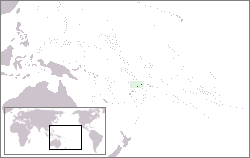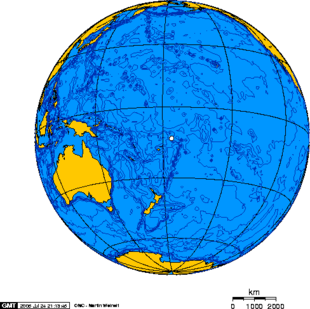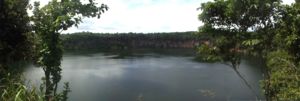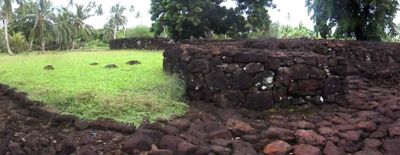Wallis and Futuna
2008/9 Schools Wikipedia Selection. Related subjects: Geography of Oceania (Australasia)
| Territoire des îles Wallis-et-Futuna | ||||||
|---|---|---|---|---|---|---|
|
||||||
| Motto: n/a | ||||||
| Anthem: La Marseillaise |
||||||
|
|
||||||
| Capital (and largest city) |
Mata-Utu |
|||||
| Official languages | French ʻUvean, Futunan |
|||||
| Government | Overseas territory of France | |||||
| - | President of France | Nicolas Sarkozy | ||||
| - | Administrateur supérieur | Richard Didier | ||||
| - | President of the Territorial Assembly | Victor Brial | ||||
| - | Kings (traditionally three) |
King of Uvea (none at present), king of Alo (none at present) Visesio Moeliku, king of Sigave since 2004 |
||||
| Non-sovereign | (overseas territory) | |||||
| Area | ||||||
| - | Total | 264 km² ( 211th) 102 sq mi |
||||
| - | Water (%) | negligible | ||||
| Population | ||||||
| - | July 2005 estimate | 15,480 ( 219th) | ||||
| - | 2003 census | 14,944 | ||||
| - | Density | 77/km² ( 112th) 199/sq mi |
||||
| GDP ( PPP) | 2004 estimate | |||||
| - | Total | $60 million ( not ranked) | ||||
| - | Per capita | $ 3,800 ( not ranked) | ||||
| Currency | CFP franc ( XPF) |
|||||
| Time zone | ( UTC+12) | |||||
| Internet TLD | .wf | |||||
| Calling code | +681 | |||||
Wallis and Futuna, officially the Territory of Wallis and Futuna Islands (French: Wallis-et-Futuna or Territoire des îles Wallis-et-Futuna, Fakauvea and Fakafutuna: Uvea mo Futuna), is a Polynesian French island territory (but not part of, or even contiguous with, French Polynesia) in the South Pacific between Fiji and Samoa. It is made up of three main volcanic tropical islands and a number of tiny islets. The territory is split into two island groups lying about 260 km apart:
- Wallis Islands (Uvea), in the north
- Wallis Island (Uvea)
- Hoorn Islands (Futuna Islands), in the south
- Futuna
- Alofi
Since 2003 Wallis and Futuna has been a French overseas collectivity ( collectivité d'outre-mer, or COM). Between 1961 and 2003, it had the status of a French overseas territory ( territoire d'outre-mer, or TOM).
History
Although the Dutch and the British were the European discoverers of the islands in the 17th and 18th centuries, it was the French who were the first Europeans to settle in the territory, with the arrival of French missionaries in 1837, who converted the population to Roman Catholicism. Wallis is named after the British explorer, Samuel Wallis.
On April 5, 1842, they asked for the protection of France after the rebellion of a part of the local population. On April 5, 1887, the queen of Uvea (on the island of Wallis) signed a treaty officially establishing a French protectorate. The kings of Sigave and Alo on the islands of Futuna and Alofi also signed a treaty establishing a French protectorate on February 16, 1888. The islands were put under the authority of the French colony of New Caledonia.
In 1917, the three traditional chiefdoms were annexed to France and turned into the Colony of Wallis and Futuna, still under the authority of the Colony of New Caledonia.
In 1959, the inhabitants of the islands voted to become a French overseas territory, effective in 1961, thus ending their subordination to New Caledonia.
In 2005 the 50th king, Tomasi Kulimoetoke II, faced being deposed after giving sanctuary to his grandson who was convicted of manslaughter. The king claimed his grandson should be judged by tribal law rather than by the French penal system. There were riots in the streets involving the king's supporters, which were victorious over attempts to replace the king. Two years later, Tomasi Kulimoetoke died on 7 May 2007. The state was in a six-month period of mourning. During this period, mentioning a successor was forbidden.
Politics
The territory is divided into three traditional chiefdoms ( royaumes coutumiers): Uvea, on the island of Wallis, Sigave, on the western part of the island of Futuna, and Alo, on the island of Alofi and on the eastern part of the island of Futuna (only Uvea is further subdivided, into three districts):
| Chiefdom District |
Capital | Area (km²) |
Population Census 2003 |
Villages |
|---|---|---|---|---|
| Wallis Islands | ||||
| `Uvea (Wallis) | Matāʻutu | 77.5 | 10071 | 23 |
| Hihifo ("west") | Vaitupu | 23.4 | 2422 | 5 |
| Hahake ("east") | Matāʻutu | 27.8 | 3950 | 6 |
| Mu'a ("first") | Mala'efo'ou (1) | 26.3 | 3699 | 12 |
| Hoorn Islands | ||||
| Sigave (Singave) | Leava | 30.0 | 1880 | 6 |
| Alo | Mala'e | 85.0 | 2993 | 9 |
| Wallis and Futuna | Matāʻutu | 192.5 | 14944 | 38 |
(1) formerly called Mua
The capital of the territory is Matāʻutu on the island of Wallis, the most populated island. As a territory of France, it is governed under the French constitution of September 28, 1958, uses the French legal system, and suffrage is universal for those over 18 years of age. The French president elected by popular vote for a five-year term; the high administrator is appointed by the French president on the advice of the French Ministry of the Interior; the presidents of the Territorial Government and the Territorial Assembly are elected by the members of the assembly.
The head of state is President Nicolas Sarkozy of France as represented by High Administrator Richard Didier (since July 19, 2006). The President of the Territorial Assembly is Pesamino Taputai (since April 1st 2001. The Council of the Territory consists of three kings (kings of the three traditional chiefdoms, who are "de jure" members) and three members appointed by the high administrator on the advice of the Territorial Assembly.
The legislative branch consists of the unicameral Territorial Assembly or Assemblée territoriale of 20 seats; the members are elected by popular vote to serve five-year terms. Wallis and Futuna elects one senator to the French Senate and one deputy to the French National Assembly.
Justice is generally administered under French law by a tribunal of first instance in Mata-Utu, but the three traditional chiefdoms administer justice according to customary law (only for non-criminal cases). The court of appeal is in Nouméa, New Caledonia.
The territory participates in the Franc Zone, and as a permanent member of the Secretariat of the Pacific Community and as an observer member of the South Pacific Forum.
Geography
Wallis and Futuna is located about two-thirds of the way from Hawaii to New Zealand, at .
The territory includes the island of Wallis (the most populated), the island of Futuna, the uninhabited island of Alofi (the population of Alofi was reportedly eaten by the cannibal people of Futuna in one single raid in the 19th century), and 20 uninhabited islets, totaling 274 square kilometres (106 sq mi) with 129 kilometres (80 mi) of coastline. The highest point in the territory is Mont Singavi (on the island of Futuna) at 765 metres (2,510 ft).
The islands have a hot, rainy season from November to April and a cool, dry season from May to October. The rains accumulate 2,500 to 3,000 millimeters (98–118 in) each year. The average humidity is 80% and the temperature 26.6 °C (79.9° F).
Only five percent of the islands' land area is arable land; permanent crops cover another 20%. Deforestation (only small portions of the original forests remain), largely as a result of the continued use of wood as the main fuel source, is a serious problem; as a consequence of cutting down the forests, the mountainous terrain of Futuna is particularly prone to erosion. There are no permanent settlements on Alofi because of the lack of natural fresh water resources.
Economy
The territory's economy is limited to traditional subsistence agriculture, with about 80% of the labor force earning its livelihood from agriculture (coconuts and vegetables), livestock (mostly pigs), and fishing. About 4% of the population is employed in government. Revenues come from French Government subsidies, licensing of fishing rights to Japan and South Korea, import taxes, and remittances from expatriate workers in New Caledonia, French Polynesia and France.
The gross domestic product had in 1995 a purchasing power parity of about $28.7 million total, about $2,000 per capita. The territory takes in about $20 million per year in revenues against about $17 million in expenditures.
Industries include copra, handicrafts, fishing, and lumber. Agricultural products include breadfruit, yams, taro, bananas, pigs, and goats. In 1995, about $370,000 worth of commodities ( copra, breadfruit, yams, taro roots, handicrafts) were exported, and about $13.5 million worth of commodities (foodstuffs, manufactured goods, transportation equipment, fuel, clothing) were imported, primarily from France, Australia, and New Zealand.
The territory uses the CFP Franc, along with the French territories of New Caledonia and French Polynesia; the CFP franc (XPF) is fixed vs. the euro, at the rate of 1,000 XPF = 8.38 euro.
Banking: In 1991, BNP Nouvelle-Calédonie, a subsidiary of BNP Paribas, established a subsidiary, Banque de Wallis-et-Futuna, which currently is the only bank in the territory. Two years earlier Banque Indosuez had closed the branch at Mata-Utu that it had opened in 1977, leaving the territory without any bank.
Demographics
The total population of the territory at the 2003 census was 14,944 (67.4% on the island of Wallis, 32.6% on the island of Futuna), the vast majority of Polynesian ethnicity, with a small minority of French descent. More than 16,000 Wallisians and Futunians live as expatriates in New Caledonia, which is more than the total population of Wallis and Futuna. The overwhelming majority of the people in Wallis and Futuna are Roman Catholic. They speak both French and Wallisian or Futunian, the indigenous Polynesian languages. However, French is only spoken by 10% of the population as a first language. Half the total population (both men and women) age 15 and over can read and write.
Culture
The culture of those islands is Polynesian, the Music of Wallis and Futuna has a rich tradition. The Kailao, often thought of as a Tongan war dance was imported to Tonga from 'Uvea.
Transportation and communications
In 1994, the territory had 1,125 telephones in use, had one AM radio station, and two television broadcast stations.
The island of Wallis has about 100 kilometers (62 mi) of highway, 16 paved, while the island of Futuna has only 20 kilometers (12.5 mi), none of it paved.
The territory has two main ports and harbors, Mata-Utu and Leava (on the island of Futuna), that support its merchant marine fleet consisting of three ships (two passenger ships and a petroleum tanker), totaling 92,060 GRT or 45,881 metric tons of deadweight (DWT).
There are two airports, one on Wallis with a paved runway of 2,100 meters (6,890 ft), and one on Futuna with a 1,000-meter (3,300 ft) unpaved strip. New Caledonia-based Aircalin operates the only commercial flights that go to Wallis, where it has an office in Mata-Utu. There are no commercial boat operators.





